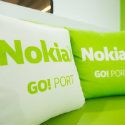
Vodafone UK is phasing Nokia out of its radio access network (RAN) and replacing the Finnish vendor with other kit suppliers, it emerged this week.
The UK mobile operator uses Nokia's RAN equipment at about 12% of its 18,000 sites, with Ericsson providing gear for roughly 56% of the footprint and China's Huawei serving the remaining 32%.
But the plan is to move to a dual-supplier network provided by Ericsson and Huawei as Vodafone embarks on the rollout of 5G technology, leaving no room for Nokia in the RAN, according to Scott Petty, Vodafone UK's chief technology officer.
The decision represents another European setback for the Finnish kit vendor after it was replaced by Ericsson in Deutsche Telekom's German RAN in late 2017.
It also comes despite a US-led backlash against Chinese vendors that some analysts have seen as a positive development for both Ericsson and Nokia.
Vodafone is determined to stick with Huawei as a RAN supplier, arguing a swap-out would cost "hundreds of millions" and "significantly" delay the UK's rollout of 5G technology.
US authorities say Huawei's equipment could include "backdoors" for Chinese spies, insisting there are close links between Huawei and Chinese state authorities.
Vodafone's assessment showed the risks of using Chinese equipment in the RAN are "manageable," said Petty, just weeks ahead of a UK government decision on whether to ban or restrict Huawei's activities.
The Vodafone move lends support to a view that Nokia has lagged Ericsson and Huawei on the development of RAN technology and is still playing catch-up as operators start to roll out their 5G networks.
Nokia's role as a RAN supplier to Three UK, signed when the smallest of the UK's network operators was building a 3G network, could also be under threat: Three announced a 5G RAN deal with Huawei last August, overlooking both Nokia and South Korea's Samsung, its supplier of 4G RAN technology.
You're invited to attend Light Reading’s Big 5G Event! Formerly the Big Communications Event and 5G North America, Big 5G is where telecom's brightest minds deliver the critical insight needed to piece together the 5G puzzle. We'll see you May 6-8 in Denver -- communications service providers get in free!
Nokia also has a deal to provide RAN equipment in rural areas for EE, the mobile subsidiary of UK telecom incumbent BT.
Although it is losing out in Vodafone's RAN, Nokia will continue to supply optical equipment for use in Vodafone's transport network -- a part of its infrastructure where it has ruled out the use of Huawei as too risky.
Huawei is also barred from providing products for the core network, where Vodafone's main supplier is Cisco.
BT has imposed similar restrictions on the Chinese vendor. It began to remove Huawei products from EE's core after acquiring the mobile operator from Deutsche Telekom and Orange in 2016.
Hailed as a 5G leader by numerous European operators, Huawei is likely to have spent at least $15 billion on research and development last year -- more than Cisco, Ericsson and Nokia combined.
While Ericsson and Nokia spend similar amounts on R&D expenses, Nokia has a much broader portfolio of technologies. Under a strategy developed by current CEO Börje Ekholm, who took charge of the business at the start of 2017, Ericsson has become even more focused on the RAN.
Related posts:
— Iain Morris, International Editor, Light Reading
About the Author(s)
You May Also Like










